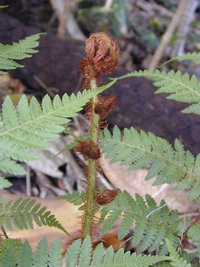Vernation
|
|

Vernation (from vernal, since that is when leaves "spring forth" in Temperate regions) is the formation of new leaves or fronds. In plant anatomy, it is the arrangement of leaves in a bud.
In pine trees, new leaves are short and encased in sheaths. Each leaf bundle consists of 2 to 5 needles. All the leaves on one section of branch grow in length together. In the cabbage, new leaves are folded over, each covered by the previous leaf.
Circinate vernation
Circinate vernation is the name given to the manner in which new fern fronds emerge. As a new fern frond is formed, it is tightly curled so that the tender growing tip of the frond (and each subdivision of the frond) is protected within a coil. At this stage it is called a crozier (after the shepherd's crook) or fiddlehead (after the scrollwork at the top of a violin). As the lower parts of the frond expand and toughen up, they begin to photosynthesize, supporting the further growth and expansion of the frond. In the case of many fronds, such as that of the Australian tree fern in the picture at right, long hairs or scales provide additional protection to the growing tips before they are fully uncoiled.
Circinate vernation may also be observed in the extension of pinnae, or leaflets, in the compound leaves of the Cycads (Division Cycadophyta).
